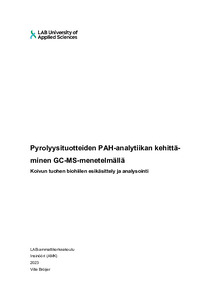Pyrolyysituotteiden PAH-analytiikan kehittäminen GC-MS-menetelmällä : koivun tuohen biohiilen esikäsittely ja analysointi
Bröijer, Ville (2023)
Bröijer, Ville
2023
All rights reserved. This publication is copyrighted. You may download, display and print it for Your own personal use. Commercial use is prohibited.
Julkaisun pysyvä osoite on
https://urn.fi/URN:NBN:fi:amk-2023051912039
https://urn.fi/URN:NBN:fi:amk-2023051912039
Tiivistelmä
Opinnäytetyön tarkoituksena oli kehittää kvantitatiivinen analyysimenetelmä polysyklisten aromaattisten hiilivetyjen (PAH) määrittämiseksi biohiilestä. Biohiili on pyrolyysiprosessista saatava tuote, jota voidaan hyödyntää esimerkiksi maanparannukseen, veden ja ilman puhdistukseen ja jopa ilmastonmuutoksen hillitsemiseen.
Pyrolyysiprosessissa syntyvät PAH-yhdisteet tuottavat haasteita biohiilen hyötykäytölle. Ne ovat ympäristössä erittäin pysyviä yhdisteitä ja monet niistä ovat karsinogeenisiä. Analyysimenetelmä PAH-yhdisteiden määrittämiseksi toimii työkaluna biohiilen turvallisuuden arvioinnissa. Koska pyrolyysiprosessin optimointi ja raaka-aineen ominaisuudet vaikuttavat suuresti PAH-yhdisteiden muodostumiseen, voidaan analyysimenetelmillä ja pyrolyysiprosessien optimoinnilla luoda kuluttajalle turvallisia biohiilituotteita.
Biohiili on näytematriisina haastava analysoida, sillä se adsorboi tehokkaasti PAH-yhdisteitä. Menetelmäkehityksessä sovellettiin standardia SFS-EN 17503, joka opastaa erilaisten maa-ainesten analysointiin hyödyntämällä LLE-uuttoa tai Soxhlet-uuttoa. Biohiilestä uutettuja PAH-yhdisteitä analysoitiin GC-MS-laitteistolla ulkoisten ja sisäisten standardien avulla. Analyysin laadunvarmistusta tuki kolmannen osapuolen sertifioidun laadunvalvontanäytteen käyttö.
Opinnäytetyössä kehitettiin TIC- ja SIM-menetelmät GC-MS-laitteistolle, sekä esikäsittelymenetelmä, jossa hyödynnettiin LLE-uuttoa. Lisäksi pohdittiin pyrolyysilaitteiston toiminnan kehittämistapoja. Esikäsittelymenetelmää ja pyrolyysiprosessin laadunvarmistusta tulisi edelleen kehittää analyysin luotettavuuden ja oikeellisuuden saavuttamiseksi. The purpose of this thesis was to develop a quantitative analysis method for the determination of polycyclic aromatic hydrocarbons (PAHs) in biochar. Biochar is a product obtained from the pyrolysis process, and it can be used, for example, in soil improvement, water and air purification, and even in mitigating climate change.
PAH compounds generated during the pyrolysis process pose challenges to the utilization of biochar. They are highly persistent in the environment, and many of them are carcinogenic. The analysis method for determining PAH compounds serves as a tool for evaluating the safety of biochar. By utilizing analysis methods and optimizing pyrolysis processes, it is possible to create biochar products that are safe for consumers. Optimization of the pyrolysis process and the properties of the raw material affect greatly the formation of PAH compounds.
Biochar is a challenging matrix to analyze because it efficiently adsorbs PAH compounds. The method development followed the standard SFS-EN 17503, which provides guidance for the analysis of various soil materials using liquid-liquid extraction (LLE) or Soxhlet extraction. PAH compounds extracted from biochar were analyzed using a GC-MS equipment using external and internal standards. The quality assurance of the analysis was supported using a third-party certified quality control sample.
In the thesis, Total Ion Chromatogram (TIC) and Selected Ion Monitoring (SIM) methods were developed for the GC-MS system, as well as a sample preparation method utilizing LLE. Additionally, ways to improve the operation of the pyrolysis apparatus were considered. The sample preparation method and quality assurance of the pyrolysis process should be further developed to achieve better yield and accuracy of the analysis.
Pyrolyysiprosessissa syntyvät PAH-yhdisteet tuottavat haasteita biohiilen hyötykäytölle. Ne ovat ympäristössä erittäin pysyviä yhdisteitä ja monet niistä ovat karsinogeenisiä. Analyysimenetelmä PAH-yhdisteiden määrittämiseksi toimii työkaluna biohiilen turvallisuuden arvioinnissa. Koska pyrolyysiprosessin optimointi ja raaka-aineen ominaisuudet vaikuttavat suuresti PAH-yhdisteiden muodostumiseen, voidaan analyysimenetelmillä ja pyrolyysiprosessien optimoinnilla luoda kuluttajalle turvallisia biohiilituotteita.
Biohiili on näytematriisina haastava analysoida, sillä se adsorboi tehokkaasti PAH-yhdisteitä. Menetelmäkehityksessä sovellettiin standardia SFS-EN 17503, joka opastaa erilaisten maa-ainesten analysointiin hyödyntämällä LLE-uuttoa tai Soxhlet-uuttoa. Biohiilestä uutettuja PAH-yhdisteitä analysoitiin GC-MS-laitteistolla ulkoisten ja sisäisten standardien avulla. Analyysin laadunvarmistusta tuki kolmannen osapuolen sertifioidun laadunvalvontanäytteen käyttö.
Opinnäytetyössä kehitettiin TIC- ja SIM-menetelmät GC-MS-laitteistolle, sekä esikäsittelymenetelmä, jossa hyödynnettiin LLE-uuttoa. Lisäksi pohdittiin pyrolyysilaitteiston toiminnan kehittämistapoja. Esikäsittelymenetelmää ja pyrolyysiprosessin laadunvarmistusta tulisi edelleen kehittää analyysin luotettavuuden ja oikeellisuuden saavuttamiseksi.
PAH compounds generated during the pyrolysis process pose challenges to the utilization of biochar. They are highly persistent in the environment, and many of them are carcinogenic. The analysis method for determining PAH compounds serves as a tool for evaluating the safety of biochar. By utilizing analysis methods and optimizing pyrolysis processes, it is possible to create biochar products that are safe for consumers. Optimization of the pyrolysis process and the properties of the raw material affect greatly the formation of PAH compounds.
Biochar is a challenging matrix to analyze because it efficiently adsorbs PAH compounds. The method development followed the standard SFS-EN 17503, which provides guidance for the analysis of various soil materials using liquid-liquid extraction (LLE) or Soxhlet extraction. PAH compounds extracted from biochar were analyzed using a GC-MS equipment using external and internal standards. The quality assurance of the analysis was supported using a third-party certified quality control sample.
In the thesis, Total Ion Chromatogram (TIC) and Selected Ion Monitoring (SIM) methods were developed for the GC-MS system, as well as a sample preparation method utilizing LLE. Additionally, ways to improve the operation of the pyrolysis apparatus were considered. The sample preparation method and quality assurance of the pyrolysis process should be further developed to achieve better yield and accuracy of the analysis.
